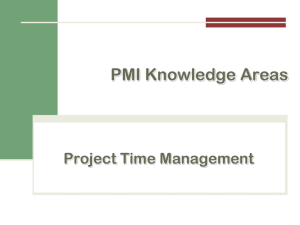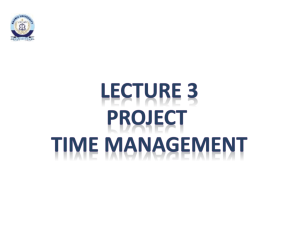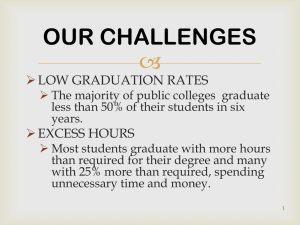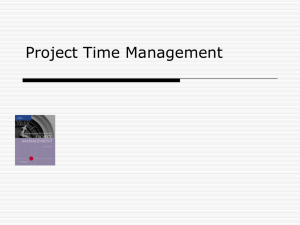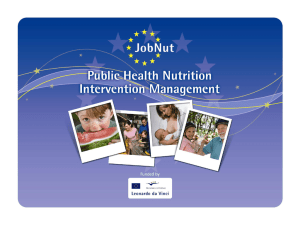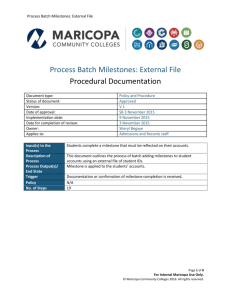9781423902201_PPT_ch04Ba
advertisement
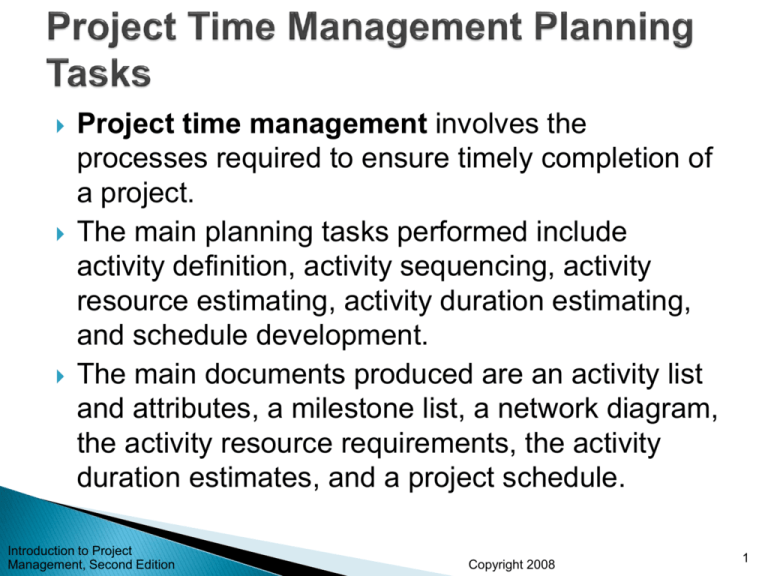
Project time management involves the processes required to ensure timely completion of a project. The main planning tasks performed include activity definition, activity sequencing, activity resource estimating, activity duration estimating, and schedule development. The main documents produced are an activity list and attributes, a milestone list, a network diagram, the activity resource requirements, the activity duration estimates, and a project schedule. Introduction to Project Management, Second Edition Copyright 2008 1 The goal of the activity definition process is to ensure that project team members have a complete understanding of all the work they must do as part of the project scope so that they can start scheduling the work. For example, how can you estimate how long it will take or what resources you need to prepare a report if you don’t have more detailed information on the report? Introduction to Project Management, Second Edition Copyright 2008 2 The activity list is a tabulation of activities to be included on a project schedule. It should include the activity name, an activity identifier or number, and a brief description of the activity. The activity attributes provide schedule-related information about each activity, such as predecessors, successors, logical relationships, leads and lags, resource requirements, constraints, imposed dates, and assumptions related to the activity. Both should be in agreement with the WBS and WBS dictionary and be reviewed by key project stakeholders. Introduction to Project Management, Second Edition Copyright 2008 3 A milestone is a significant event in a project. It often takes several activities and a lot of work to complete a milestone, but the milestone itself is like a marker to help identify necessary activities. There is usually no cost or duration for a milestone. Project sponsors and senior managers often focus on major milestones when reviewing projects. Sample milestones for many projects include: ◦ Sign-off of key documents ◦ Completion of specific products ◦ Completion of important process-related work, such as awarding a contract to a supplier Introduction to Project Management, Second Edition Copyright 2008 4 The SMART criteria suggest that milestones should be: ◦ ◦ ◦ ◦ ◦ Specific Measureable Assignable Realistic Time-framed You can also use milestones to help reduce schedule risk by following these best practices: ◦ Define milestones early in the project and include them in the Gantt chart to provide a visual guide. ◦ Keep milestones small and frequent. ◦ The set of milestones must be all-encompassing. ◦ Each milestone must be binary, meaning it is either complete or incomplete. ◦ Carefully monitor the milestones on the critical path.* *Luc K. Richard, “Reducing Schedule Risk, Parts 1 and 2,” (www.Gantthead.com) (November 10, 2003 and January 31, 2005). Introduction to Project Management, Second Edition Copyright 2008 5 Activity sequencing involves reviewing the activity list and attributes, project scope statement, and milestone list to determine the relationships or dependencies between activities. A dependency or relationship relates to the sequencing of project activities or tasks. ◦ For example, does a certain activity have to be finished before another one can start? ◦ Can the project team do several activities in parallel? ◦ Can some overlap? Activity sequencing has a significant impact on developing and managing a project schedule. Introduction to Project Management, Second Edition Copyright 2008 6 Network diagrams are the preferred technique for showing activity sequencing. A network diagram is a schematic display of the logical relationships among, or sequencing of, project activities. ◦ In the activity-on-arrow (AOA) approach, or the arrow diagramming method (ADM), activities are represented by arrows and connected at points called nodes (starting and ending point of an activity) to illustrate the sequence of activities; only show finish-to-start dependencies (most common type of dependency). ◦ The precedence diagramming method (PDM) is a network diagramming technique in which boxes represent activities. These are more widely used as they can show all dependency types. Introduction to Project Management, Second Edition Copyright 2008 7 Introduction to Project Management, Second Edition Copyright 2008 8 Introduction to Project Management, Second Edition Copyright 2008 9 Duration includes the actual amount of time spent working on an activity plus elapsed time. ◦ For example, even though it might take one workweek or five workdays to do the actual work, the duration estimate might be two weeks to allow extra time needed to obtain outside information or to allow for resource availability. Effort is the number of workdays or work hours required to complete a task. ◦ A duration estimate of one day could be based on eight hours of work or 80 hours of work. Duration relates to the time estimate, not the effort estimate; the two are related, so project team members must document their assumptions when creating duration estimates and update the estimates as the project progresses. Introduction to Project Management, Second Edition Copyright 2008 10 Duration estimates are often provided as discrete estimates, such as four weeks. A range estimate might be between three and five weeks. A three-point estimate is an estimate that includes an optimistic, most likely, and pessimistic estimate, such as three, four, and five weeks. Introduction to Project Management, Second Edition Copyright 2008 11 Schedule development uses the results of all the preceding project time management processes to determine the start and end dates of project activities and of the entire project. The resulting project schedule is often shown on a Gantt chart, a standard format for displaying project schedule information by listing project activities and their corresponding start and finish dates in a calendar format. The ultimate goal of schedule development is to create a realistic project schedule that provides a basis for monitoring project progress for the time dimension of the project. Introduction to Project Management, Second Edition Copyright 2008 12 Introduction to Project Management, Second Edition Copyright 2008 13 Critical path method (CPM)—also called critical path analysis—is a network diagramming technique used to predict total project duration. A critical path for a project is the series of activities that determine the earliest time by which the project can be completed. It is the longest path through the network diagram and has the least amount of slack or float. ◦ Slack or float is the amount of time an activity may be delayed without delaying a succeeding activity or the project finish date. The longest path or the path containing the critical tasks is what is driving the completion date for the project. Introduction to Project Management, Second Edition Copyright 2008 14 The critical path shows the shortest time in which a project can be completed. If one or more of the activities on the critical path takes longer than planned, the whole project schedule will slip unless the project manager takes corrective action. For example: Apple Computer team members put a stuffed gorilla on top of the cubicle of whoever was in charge of a critical task, so they would not distract him or her. Introduction to Project Management, Second Edition Copyright 2008 15 It is important to know what the critical path is throughout the life of a project so that the project manager can make trade-offs. If one of the tasks on the critical path is behind schedule, should the schedule be renegotiated with stakeholders, or should more resources be allocated to other items on the critical path to make up for that time? It is also common for project stakeholders to want to shorten project schedule estimates, so you need to know what tasks are on the critical path. Introduction to Project Management, Second Edition Copyright 2008 16 Crashing is a technique for making cost and schedule trade-offs to obtain the greatest amount of schedule compression for the least incremental cost. ◦ If two critical tasks each take two weeks, and it will take $100 to shorten Task 1 by a week and $1,000 to shorten Task 2 by a week, shorten Task 1. Fast tracking involves doing activities in parallel that you would normally do in sequence. ◦ Instead of waiting for Task 1 to be totally finished before starting Task 2, start Task 2 when Task 1 is halfway done. Schedule compression often backfires by causing cost, human resource, and quality problems, which lead to even longer schedules. Introduction to Project Management, Second Edition Copyright 2008 17 Introduction to Project Management, Second Edition Copyright 2008 18 A buffer is additional time to complete a task. Murphy’s Law states that if something can go wrong, it will. Parkinson’s Law states that work expands to fill the time allowed. In traditional estimates, people often add a buffer to each task and use it if it’s needed or not. Critical chain scheduling removes buffers from individual tasks and instead creates: ◦ A project buffer or additional time added before the project’s due date. ◦ Feeding buffers or additional time added before tasks on the critical path. Introduction to Project Management, Second Edition Copyright 2008 19 Introduction to Project Management, Second Edition Copyright 2008 20 Introduction to Project Management, Second Edition Copyright 2008 21 Project teams normally prepare cost estimates at various stages of a project, and these estimates should be fine-tuned as time progresses. It is also important to provide supporting details for the estimates, including ground rules and assumptions. A large percentage of total project costs is often labor costs, so it is important to do a good job estimating labor hours and costs. Introduction to Project Management, Second Edition Copyright 2008 22 Analogous estimates, also called top-down estimates, use the actual cost of a previous, similar project as the basis for estimating the cost of the current project. This technique requires a good deal of expert judgment and is generally less costly than others are, but it can also be less accurate. Bottom-up estimates involve estimating individual activities and summing them to get a project total. This approach can increase the accuracy of the cost estimate, but it can also be time intensive and, therefore, expensive to develop. Parametric modeling uses project characteristics (parameters) in a mathematical model to estimate project costs. Introduction to Project Management, Second Edition Copyright 2008 23 Introduction to Project Management, Second Edition Copyright 2008 24 Project cost budgeting involves allocating the project cost estimate to tasks over time. The tasks are based on the work breakdown structure for the project. The main goal of the cost budgeting process is to produce a cost baseline, or time-phased budget, that project managers use to measure and monitor cost performance. Introduction to Project Management, Second Edition Copyright 2008 25 Introduction to Project Management, Second Edition Copyright 2008 26

